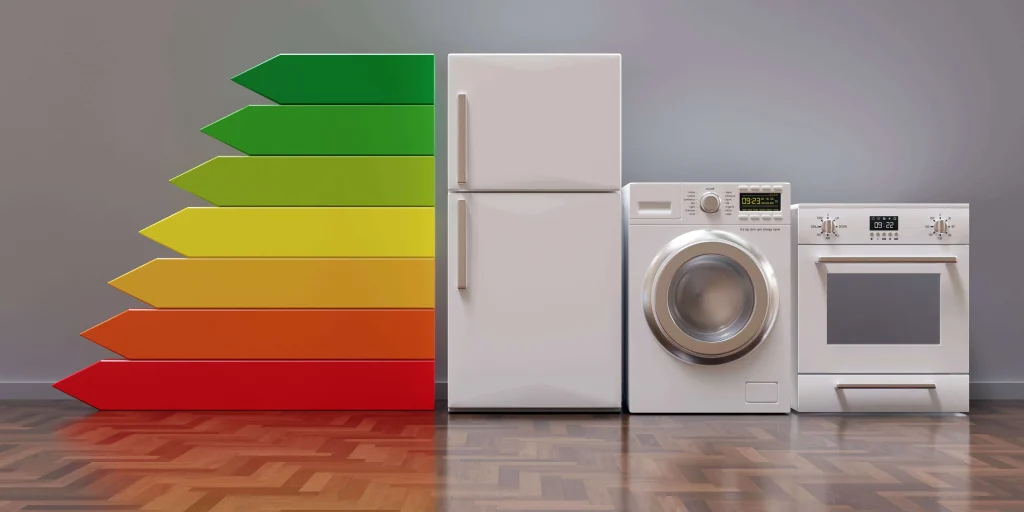When you look at the appliances placed in the rooms of your RFO house and lot, you will see that there are stickers attached to the appliances that were there even before you purchased the appliance. These stickers are placed there typically to indicate that the appliance has passed product standards that determine if the appliance is fit to be used. One of these stickers is the energy label.
The importance of energy labels
The energy label is a sticker on an appliance that provides information on the appliance’s energy efficiency. Learning how to understand an energy label lets you learn which appliances have better energy efficiency or less energy consumption. This is important for making smart purchasing decisions when it comes to buying energy-efficient products for your RFO house and lot.
Appliances that are more energy efficient will be able to function optimally with less energy usage, thereby making it more cost-effective for your utility bills. By reading an energy label when choosing what appliances to purchase, you will be able to better compare similar appliances regarding the energy consumed and which is more efficient than the other. Appliances that are energy efficient also generate fewer greenhouse gases as they consume less electricity.
How Energy Labels Are Read
The format of displaying information for an energy label differs depending on what organization gives out the energy label, although they all essentially give out the same kind of information. What’s indicated by the energy label is the energy efficiency of appliances. Through the energy label, energy efficient appliances have better energy consumption, and this is indicated through two main pieces of information: a figure such as an energy efficiency ratio or energy efficiency factor, and an energy star rating.
Energy figure
Figures in an energy label indicate an estimate of the power consumption or energy consumption of an appliance. This information is typically provided through how many kilowatt-hours an appliance uses over a year. Although, the power consumption of an appliance primarily depends on how frequently it is used.
For example, the energy figure of refrigerators is calculated with the assumption that they are used for 24 hours a day, dishwashers for 7 uses each week, computers and televisions for 10 hours a day, and clothes washers for 7 uses each week.

Energy star
An energy star is a way of indicating the energy efficiency of appliances. Energy-efficient products are able to provide performance that is comparable to similar models while using up less energy, thereby having better energy performance. The more energy star label that an appliance has, the more it is an energy-efficient appliance.
Energy star labels are calculated differently for different models. For example, televisions are given energy stars depending on their screen size, while air conditioners are given energy stars depending on the amount of cooling per energy usage.
The Philippine Energy Labelling Program (PELP)
In the Philippines, the Department of Energy (DOE) is the one that issues an energy label for each and every appliance that goes through the standard procedures of energy label issuance. It is in compliance with the Republic Act 11285, or the “Energy Efficiency and Conservation Act” that the PELP aims to provide a labeling system for products that consume energy.
The purpose of the PELP
Through the PELP, the objective is to foster consumer behavior that pays better attention to the purchasing of appliances or products that possess energy efficiency. The achievement of this objective is done by placing an energy label on appliances to provide information to consumers regarding the energy efficiency of products or appliances.
The energy label compliant with the standards of the DOE include an energy star rating system that depends on the kind of appliance whose energy efficiency is being measured. The energy star rating system also depends on the appliance’s minimum energy performance, serving as the lower efficiency rating limit for 1 energy star.
Where is the energy label located?
The energy label is placed at an area of the appliance that is clearly seen and provides the product model details and estimations of energy consumption, like a sample electricity consumption that provides the consumer with the energy consumption of the product per month. Moreover, a QR code is typically available on the energy label that can be scanned to provide more information to the consumer regarding the product or appliance’s PELP information. Look out for a yellow tag or label on appliances in stores, these are usually the energy labels.

Energy Guide Label Philippines
Through the PELP, the DOE is able to set a standard that products or appliances must meet in order to be issued an energy label that will inform consumers of the energy efficiency of a functional appliance or product to be used in an RFO house and lot. At present, the DOE continues to expand product coverage of energy labeling, including products involved in food processing, personal care, laundry, cooking, cleaning, ventilating, lighting, communication technology, heating, grooming, and the like.
Primarily, the energy labels cover refrigerating appliances, air conditioners, washing machines, lighting appliances, and televisions. With this, the DOE has a standard called the Minimum Energy Performance Product (MEPP), which serves s the minimum standard set by the DOE regarding the energy performance of appliances or products. Better energy performance is shown by having more stars on the energy label of a product or appliance.
Refrigerators
The energy label on refrigerators includes operating cost computations, product specifications, and the energy efficiency factor of the product.
Compact Fluorescent Lamps
The energy label on compact fluorescent lamps (CFL) includes the energy efficiency, power consumption, average life expectancy, and total lighting output of the CFL.
Air Conditioners
The energy label on air conditioners, portable air conditioners, and such, includes the energy efficiency ratio, minimum energy performance standards, product specifications, and operating cost computations.
Energy labels provide consumers with information that could affect them in the long run such as cost effectiveness, durability, energy sustainability, and most importantly energy efficiency. Check out these tags before your next big appliance purchase.
Read more: How to Keep your Appliances Safe at your Crown Asia Home


